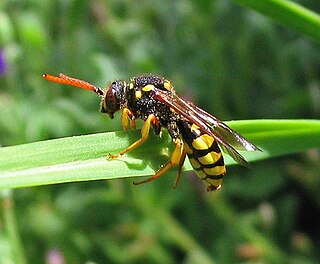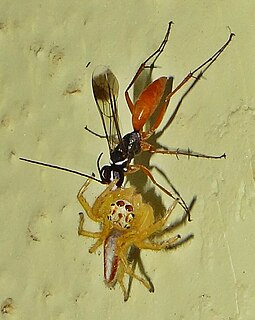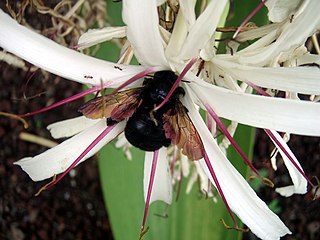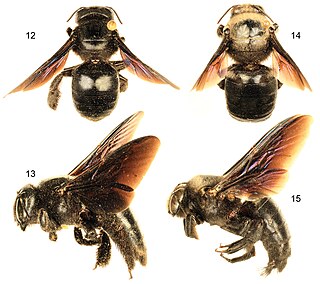| Macropis | |
|---|---|
 | |
| Macropis sp. | |
| Scientific classification | |
| Kingdom: | Animalia |
| Phylum: | Arthropoda |
| Class: | Insecta |
| Order: | Hymenoptera |
| Family: | Melittidae |
| Genus: | Macropis Panzer, 1809 |
| Species | |
See text | |
Macropis is a genus of bees.
| Macropis | |
|---|---|
 | |
| Macropis sp. | |
| Scientific classification | |
| Kingdom: | Animalia |
| Phylum: | Arthropoda |
| Class: | Insecta |
| Order: | Hymenoptera |
| Family: | Melittidae |
| Genus: | Macropis Panzer, 1809 |
| Species | |
See text | |
Macropis is a genus of bees.
Macropis species are of moderate size, not exceeding 15 mm. They have a livery predominantly black; males are characterized by conspicuous yellow markings on the head, but the females show morphological adaptations related to their foraging habits of flower oils, posterior tibiae with very developed, covered with a dense velvety hairs. [1] Unlike most Melittidae, the wing has only two submarginal cells.
They are solitary bees that dig their nests in the ground. Most species are oligolectic and feed on pollen and floral oils of Lysimachia spp. They make a single generation per year. The males emerge from the ground in spring, just before the females, and await the females in the vicinity of the flowers of the host plant. After mating, the females dig a nest in the ground, ending with one or two rooms in which is collected the pollen, which is placed on the egg. The larvae, feeding on the pollen, develop rapidly, and within 10 days turn into pupae, spending the winter in this stage. Macropis nests are often parasitized by bee cleptoparasites such as Epeoloides . [2]

Bees are flying insects closely related to wasps and ants, known for their role in pollination and, in the case of the best-known bee species, the western honey bee, for producing honey. Bees are a monophyletic lineage within the superfamily Apoidea. They are presently considered a clade, called Anthophila. There are over 16,000 known species of bees in seven recognized biological families. Some species – including honey bees, bumblebees, and stingless bees – live socially in colonies while some species – including mason bees, carpenter bees, leafcutter bees, and sweat bees – are solitary.

Megachile rotundata, the alfalfa leafcutting bee, is a European bee that has been introduced to various regions around the world. As a solitary bee species, it does not build colonies or store honey, but is a very efficient pollinator of alfalfa, carrots, other vegetables and some fruits. Because of this, farmers often use M. rotundata as a pollination aid by distributing M. rotundata prepupae around their crops. Each female will construct and provision her own nest, which is built in old trees or log tunnels. Being a leafcutter bee, these nests are lined with cut leaves. These bees feed on pollen and nectar and display sexual dimorphism. This species has been known to bite and sting, however it poses no overall danger unless it is threatened or harmed and its sting has been described as half as painful as a honey bee's.

Halictidae is the second-largest family of Anthophila bees. Halictid species occur all over the world and are usually dark-colored and often metallic in appearance. Several species are all or partly green and a few are red; a number of them have yellow markings, especially the males, which commonly have yellow faces, a pattern widespread among the various families of bees. The family is distinguished by the arcuate basal vein found on the wing.

With over 850 species, the genus Nomada is one of the largest genera in the family Apidae, and the largest genus of kleptoparasitic "cuckoo bees." Kleptoparasitic bees are so named because they enter the nests of a host and lay eggs there, stealing resources that the host has already collected. The name "Nomada" is derived from the Greek word nomas (νομάς), meaning "roaming" or "wandering."

Melittinae is a small melittid subfamily, with some 60 species in four genera, restricted to Africa and the northern temperate zone. They are typically small to moderate-sized bees, which often have shaggy scopae, and are commonly oligolectic; several species further specialize on floral oils as larval food rather than pollen, including Rediviva emdeorum, a highly unusual species in which the forelegs are longer than the entire body, and used to sponge up the floral oil at the end of elongated corolla spurs of the host plant, Diascia.

The genus Megachile is a cosmopolitan group of solitary bees, often called leafcutter bees or leafcutting bees; it also includes the called resin bees and mortar bees. While other genera within the family Megachilidae may chew leaves or petals into fragments to build their nests, certain species within Megachile neatly cut pieces of leaves or petals, hence their common name. This is one of the largest genera of bees, with more than 1500 species in over 50 subgenera. The introduced alfalfa leafcutter bee is managed for crop pollination in various regions around the world.

Andrena, commonly called the mining bee, is the largest genus in the family Andrenidae, and is nearly worldwide in distribution, with the notable exceptions of Oceania and South America. With over 1,300 species, it is one of the largest of all bee genera. Species are often brown to black with whitish abdominal hair bands, though other colors are possible, most commonly reddish, but also including metallic blue or green.

Melitta is a genus of bees in the family Melittidae. It includes about 40 species restricted to Africa and the northern temperate zone. Most of the species are Palaearctic, though three rare species occur in North America.

The cosmopolitan bee genus Ceratina, often referred to as small carpenter bees, is the sole lineage of the tribe Ceratinini, and closely related to the more familiar carpenter bees. They make nests in dead wood, stems, or pith, and while many are solitary, a number are subsocial, with mothers caring for their larvae, and in a few cases where multiple females are found in a single nest, daughters or sisters may form very small, weakly eusocial colonies. One species is unique for having both social and asocial populations, Ceratina australensis, which exhibits all of the pre-adaptations for successful group living. This species is socially polymorphic with both solitary and social nests collected in sympatry. Social colonies in that species consist of two foundresses, one contributing both foraging and reproductive effort and the second which remains at the nest as a passive guard. Cooperative nesting provides no overt reproductive benefits over solitary nesting in this population, although brood survival tends to be greater in social colonies. Maternal longevity, subsociality and bivoltine nesting phenology in this species favour colony formation, while dispersal habits and offspring longevity may inhibit more frequent social nesting in this and other ceratinines.

Mass provisioning is a form of parental investment in which an adult insect, most commonly a hymenopteran such as a bee or wasp, stocks all the food for each of her offspring in a small chamber before she lays the egg. This behavior is common in both solitary and eusocial bees, though essentially absent in eusocial wasps.

Xylocopa sonorina, the valley carpenter bee or Hawaiian carpenter bee, is a species of carpenter bee found from western Texas to northern California, and the eastern Pacific islands. Females are black while males are golden-brown with green eyes.

Dasypoda is a genus of bees in the family Melittidae.

Andrena agilissima is a species of mining bee. They are present in most of Europe, the Near East and North Africa and can be found from April through July. Andrena agilissima is an oligolectic species, feeding only on the pollen of a few genera of Cruciferous vegetables.

Panurgus is a genus of mining bees belonging to the family Andrenidae, subfamily Panurginae.

Xylocopa sulcatipes is a large Arabian carpenter bee. These multivoltine bees are known to take part in social nesting and cooperative nesting. These metasocial carpenter bees nest in thin dead branches. One or more cooperating females build many brood cells. They have been extensively studied in Saudi Arabia and Israel.
Hesperapis is a genus of evening bees in the family Melittidae. There are at least 30 described species in Hesperapis.

Macropis nuda is a ground nesting, univoltine bee native to northern parts of North America. Thus, this species cocoons as pupae and hibernates over the winter. The species is unique as it is an oligolectic bee, foraging mainly for floral oils from Primulaceae of the genus Lysimachia.

Dasypoda hirtipes, the pantaloon bee or hairy-legged mining bee is a species of solitary mining bee from the family Melittidae. It is a widespread bee which is found from Great Britain to China.

Melittidae is a small bee family, with over 200 described species in three subfamilies. The family has a limited distribution, with all described species restricted to Africa and the northern temperate zone.
Hesperapis oraria, known generally as the gulf coast evening bee or gulf coast solitary bee, is a rare species of bee in the family Melittidae. It was first described in 1997. The bee's current known range is on the barrier islands and coastal mainland secondary dunes on the Gulf Coast of the United States in Florida, Alabama, and Mississippi. The Gulf Coast solitary bee is the only known member of its subfamily in the eastern United States, and it is a monolege of the coastal plain honeycomb head.
| | This bee-related article is a stub. You can help Wikipedia by expanding it. |